|
 Boundary Waters Quetico Forum
Boundary Waters Quetico Forum Gear Forum Gear Forum Power sources for fish detectors Power sources for fish detectors
|
Author
Text
02/11/2014 05:31PM
My fish detector draws between 130 and 180 ma so all of my tests are with a current draw of 130ma. Most fish detectors are designed to run on the led acid battery that is for the boat motor. Those batteries run between 12 and 16 volts. I find that most fish detectors operate well down to about 10 volts and completely quit at 8 volts. I am interested in a power source between 10 and 18 volts The first thing I did was to make a current regulator and voltage divider to put a known load on a battery. I used a ARDUINO with a Shield that has a SD card to save data on one time every minute.
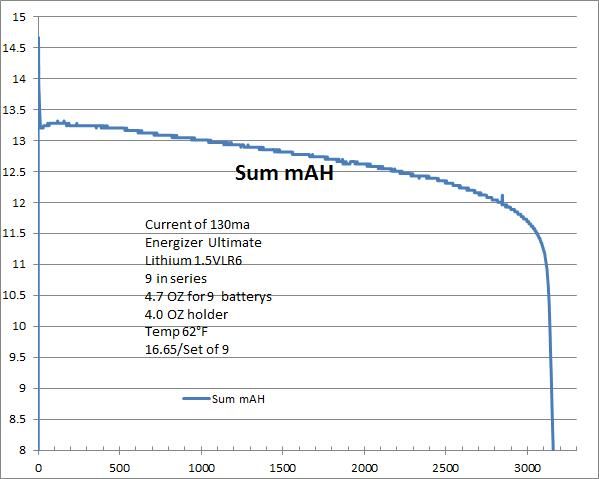
The data was in a text file that I loaded into Excel to plot the data.
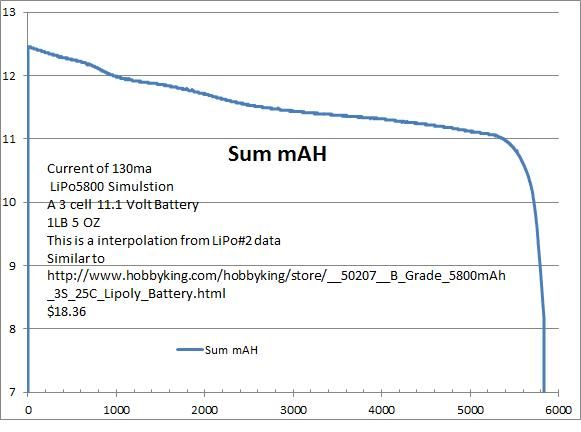
Like this one LiPo Battery
LiPo batteries require special chargers and a protection circuit to prevent over discharge. This is a grade B battery. That means there is something wrong with it. Usually that means there is internal resistance. The hobby users want high output and this means high current frequently above 10 amps. The power loss on internal resistance is I^2 *R*Time. Fish detector use will draw 100 times less current for 100 times longer. This means the loss on the internal resistance will be 100 times lower than helicopter or race car.
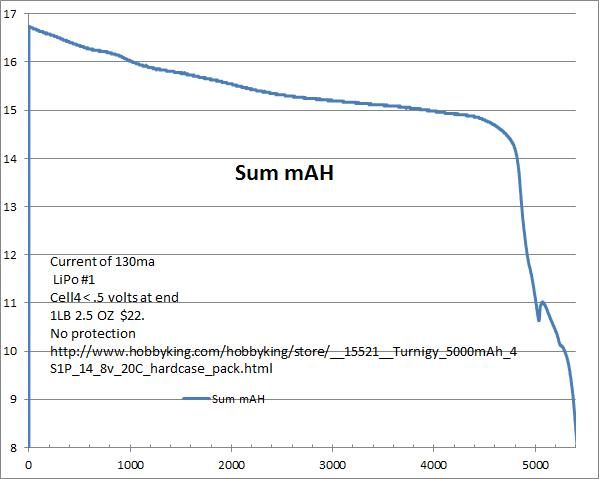
LiPo batteries require special chargers and a protection circuit to prevent over discharge.
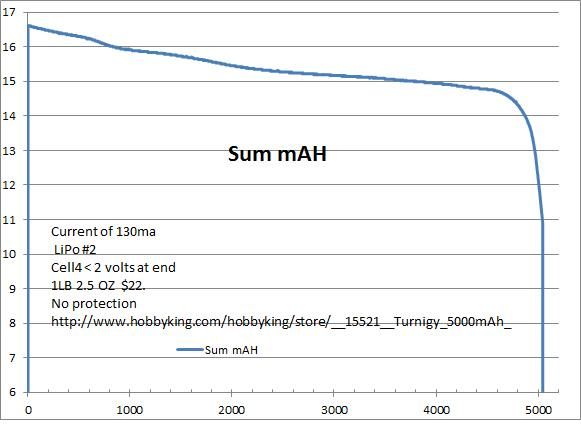
LiPo batteries require special chargers and a protection circuit to prevent over discharge.
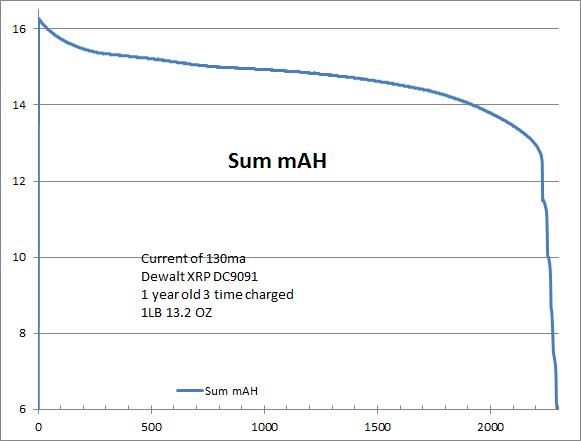
The question of the day is Freedom or Socialism?? MagicPaddler

The data was in a text file that I loaded into Excel to plot the data.

Like this one LiPo Battery
LiPo batteries require special chargers and a protection circuit to prevent over discharge. This is a grade B battery. That means there is something wrong with it. Usually that means there is internal resistance. The hobby users want high output and this means high current frequently above 10 amps. The power loss on internal resistance is I^2 *R*Time. Fish detector use will draw 100 times less current for 100 times longer. This means the loss on the internal resistance will be 100 times lower than helicopter or race car.

LiPo batteries require special chargers and a protection circuit to prevent over discharge.

LiPo batteries require special chargers and a protection circuit to prevent over discharge.

The question of the day is Freedom or Socialism?? MagicPaddler
02/11/2014 08:32PM
I think I would just bring a secondary nuclear power plant. Great analysis, I'm sure. Unfortunately, I am not qualified to say much more beyond that. Now, if you want to talk about pumps, I could probably put you to sleep pretty quickly. That's my business. All in fun though - Not trying to diss anyone.
Tomster
Tomster
02/11/2014 09:46PM
quote Moonman: "I was just thinking that Ragged would love this. :)
Maybe you could give us a short written synopsis of each battery set up?
Moonman."
I do like this stuff :)
Nice job on the project!
I've always had bad luck with Lipos, not sure why but they always seem to kick the bucket allot faster than Lion, I have some RC Helis that just eat them up but then again they see much higher discharge rates than my Lion projects. A few years ago Lipos were pretty cost prohibited but they have really come down in price, and the non cylindrical shape is sure nice for reducing the size of the pack.... have been thinking about playing with some....
He leads me beside quiet waters, he restores my soul. Psalm 23:2/3
02/11/2014 10:03PM
Wow, failed with your first assumption...
Fish finders should be run from an isolated power source so as to not pick up on the electricel noise given off by the other electronics of the system.
Now as for the rest of the data it looks to be correct....lol
(All of my post is of course poking fun at this analysis of course, I know nothing about any of it...except for what a sales guy told me once.)
Everyone knows how you can tell if a salesman is lying?
His lips are moving
Fish finders should be run from an isolated power source so as to not pick up on the electricel noise given off by the other electronics of the system.
Now as for the rest of the data it looks to be correct....lol
(All of my post is of course poking fun at this analysis of course, I know nothing about any of it...except for what a sales guy told me once.)
Everyone knows how you can tell if a salesman is lying?
His lips are moving
I'm just here to give my opinion...If you don't like it, ignore it.
02/12/2014 06:55AM
Gsfisher13
I forgot to post the 10 alkaline batteries. This would be similar to what you use. That is what I have used for years and it works well. Is there something cheaper, lighter that will last longer.

Look at the 10 volt line to see how many mil amperes hours (mAH) you will get out of this battery combination.
1820 mAH, 8.8 Oz and cost about $12.90 $12.90/1.82AH = $7.08/AH
Now to compare that to Energizer Ultimate Lithium (first plot)
3200 mAH, 4.7 Oz and cost about $$16.65 $16.65/3.2AH= $5.20/AH
So the Lithiums are lighter and cheaper per hour of operation.
Ragged
Do you use over discharge protection on your LiPos? Look at my fourth graph LiPo#1. See that little glitch on the falling edge at about 10 volts. That occurred because one of the cells has gone below zero volts and that is where it shorted out raising the output voltage and irreversible destroying that cell.
I have one of THESE on order.
I forgot to post the 10 alkaline batteries. This would be similar to what you use. That is what I have used for years and it works well. Is there something cheaper, lighter that will last longer.

Look at the 10 volt line to see how many mil amperes hours (mAH) you will get out of this battery combination.
1820 mAH, 8.8 Oz and cost about $12.90 $12.90/1.82AH = $7.08/AH
Now to compare that to Energizer Ultimate Lithium (first plot)
3200 mAH, 4.7 Oz and cost about $$16.65 $16.65/3.2AH= $5.20/AH
So the Lithiums are lighter and cheaper per hour of operation.
Ragged
Do you use over discharge protection on your LiPos? Look at my fourth graph LiPo#1. See that little glitch on the falling edge at about 10 volts. That occurred because one of the cells has gone below zero volts and that is where it shorted out raising the output voltage and irreversible destroying that cell.
I have one of THESE on order.
The question of the day is Freedom or Socialism?? MagicPaddler
02/12/2014 07:12AM
quote gsfisher13: "Um at the risk of sounding simple, I use a 10 pack of AA (Sony envelop) batteries that start around 14-15 volts and powers my fishfinder for a day of fishing."
IMHO you should be running 12 cells to make it worth your while, those battery's have an even lower voltage than a regular AA so you will it that 10volt cutoff pretty fast, even if the finder is still on at 10volts and below it won't be working correctly.
quote MagicPaddler: "Gsfisher13
I forgot to post the 10 alkaline batteries. This would be similar to what you use. That is what I have used for years and it works well. Is there something cheaper, lighter that will last longer.
Look at the 10 volt line to see how many mil amperes hours (mAH) you will get out of this battery combination.
1820 mAH, 8.8 Oz and cost about $12.90 $12.90/1.82AH = $7.08/AH
Now to compare that to Energizer Ultimate Lithium (first plot)
3200 mAH, 4.7 Oz and cost about $$16.65 $16.65/3.2AH= $5.20/AH
So the Lithiums are lighter and cheaper per hour of operation.
Ragged
Do you use over discharge protection on your LiPos? Look at my fourth graph LiPo#1. See that little glitch on the falling edge at about 10 volts. That occurred because one of the cells has gone below zero volts and that is where it shorted out raising the output voltage and irreversible destroying that cell.
I have one of THESE on order.
"
I do run protection boards on all the packs I make, I also balance charge the cells every so often to make sure one isn't getting out of wack, I'd balance charge ever time but the housings I made are waterproof and I haven't yet found a workable plug for balance charging that would be sleek and easy to waterproof, plus then I'd have to deal with sealing it when the pack is in use, I really just need a waterproof door on the housing for that feature.
Really cool data, to me that's about as useful as it gets, you should test some generic(Ultrafire ect) Ebay lion cells, the ones that claim 3000mah but you know they are really 1800 lol
I might have to have my EE buddy at work make me something similar, would be nice to plot data from a thermoelectric charge session.
He leads me beside quiet waters, he restores my soul. Psalm 23:2/3
02/12/2014 08:15AM
Rags
You say run more cells in series to get higher voltage. Many people are running 8 AA and I have not been able to convince them to run 10 AA to get better performance and life. Most detectors shut off at about 8 volts and I have been able to see trout at 40 ft when the voltage was at 10 volts. I agree 12 volts would probably give better response but can you see degradation of response at 10 or 11 volts?
Magic
You say run more cells in series to get higher voltage. Many people are running 8 AA and I have not been able to convince them to run 10 AA to get better performance and life. Most detectors shut off at about 8 volts and I have been able to see trout at 40 ft when the voltage was at 10 volts. I agree 12 volts would probably give better response but can you see degradation of response at 10 or 11 volts?
Magic
The question of the day is Freedom or Socialism?? MagicPaddler
02/12/2014 09:27AM
quote MagicPaddler: "Rags
You say run more cells in series to get higher voltage. Many people are running 8 AA and I have not been able to convince them to run 10 AA to get better performance and life. Most detectors shut off at about 8 volts and I have been able to see trout at 40 ft when the voltage was at 10 volts. I agree 12 volts would probably give better response but can you see degradation of response at 10 or 11 volts?
Magic
"
I think 10 alkalines (1.5 volts) is just fine, but those recharchables are lower voltage I know my P230 seems to wig out below the 10 volts the manufacturer recommends, it will start giving very odd depth readings, like 4ft when I'm in 30 ft, and my Ice55 flasher goes all crazy as well, maybe its a Hummingbird thing lol I have never noticed any issues at 11 volts, but that's just me, its when it gets to the sated 10 volts that the gremlins in my finders start to show up.
You should take your board and run 8 AA's of the same type as your last one and we could actually see what the usable mAH/per oz is, I've always assumed you would get a better time/weight number from 10 cells over 8 but it would be nice to see it!
Looks like above you are getting around 1840 mAH out of the 10 AA's, 209 usable (above 10 volts) mAH/oz, so the 8 cell pack would have to be @ or above 1471 mAH@ 10 volts to make sense. It would be very interesting to see if that's the case, if I had to guess based on curves I've seen before I'm going predict it will be in the 800-1000 mAH range, putting at 142 mAH/oz range, much less than the 10 cell pack.
Thanks for posting this stuff!
He leads me beside quiet waters, he restores my soul. Psalm 23:2/3
02/12/2014 12:33PM
Cool idea. I wonder if you could just use the PWM or a DAC off the Arduino to drive the FET directly - then you could program the load to anything you wanted.
I've been thinking of chucking all my crappy eveready rechargeable NiMH AA's and buying the Sanyo Eneloop-XX AA batteries and a solar panel. Not exactly sure how you'd charge 10 AA's at the same time though. But if you could, you could maybe go to AAA's and then maybe get your battery pack weight down to 6oz or so.
I've been thinking of chucking all my crappy eveready rechargeable NiMH AA's and buying the Sanyo Eneloop-XX AA batteries and a solar panel. Not exactly sure how you'd charge 10 AA's at the same time though. But if you could, you could maybe go to AAA's and then maybe get your battery pack weight down to 6oz or so.
02/12/2014 02:08PM
NotLight
I think you could use one of the ARDUINO analog out puts to control the current. Then have the ARDUINO in the feedback circuit. The reference could be a constant set before the test or a output from a pot.
For now this does what I want.
NiMH are heavy look at smaller LiPo batteries. Anything over 1000 mAH should run a detector for one days fishing.
Magic
I think you could use one of the ARDUINO analog out puts to control the current. Then have the ARDUINO in the feedback circuit. The reference could be a constant set before the test or a output from a pot.
For now this does what I want.
NiMH are heavy look at smaller LiPo batteries. Anything over 1000 mAH should run a detector for one days fishing.
Magic
The question of the day is Freedom or Socialism?? MagicPaddler
02/12/2014 03:00PM
Interesting. It would be neat to have the small 1000mah battery. 14.8V?
I am thinking something like this - Arduino driving a simple op-amp current source by the PWM, feedback loop in the op-amp circuit and not the Arduino. (With some kind of overcurrent protection so you don't start a battery fire - not sure how to do that.)

I am thinking something like this - Arduino driving a simple op-amp current source by the PWM, feedback loop in the op-amp circuit and not the Arduino. (With some kind of overcurrent protection so you don't start a battery fire - not sure how to do that.)

02/12/2014 03:57PM
A 14.8V is a 4 cell battery. The protection The battery
Some of their batteries do not have the balance leads brought out. You would also need some connectors to connect to the balance connector and power leads. This battery would need a charger that would use the balance leads.
Some of their batteries do not have the balance leads brought out. You would also need some connectors to connect to the balance connector and power leads. This battery would need a charger that would use the balance leads.
The question of the day is Freedom or Socialism?? MagicPaddler
02/13/2014 02:32PM
Some people use RYOBI drill batteries to power their detectors. A friend Mr Q loaned me 2 of them to test. These are 3&1/2 years old mostly used for powering a detector. I called them RUOBI 1 and RYOBI 2.
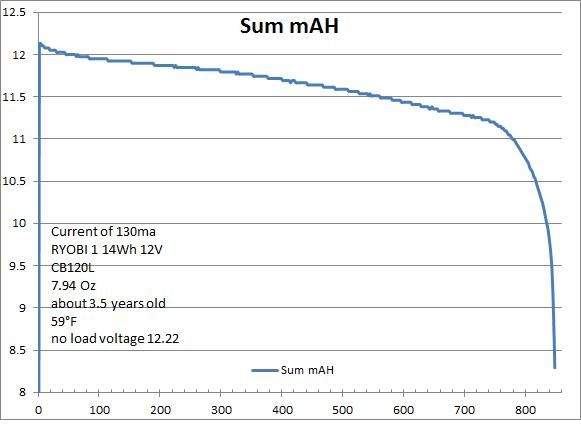
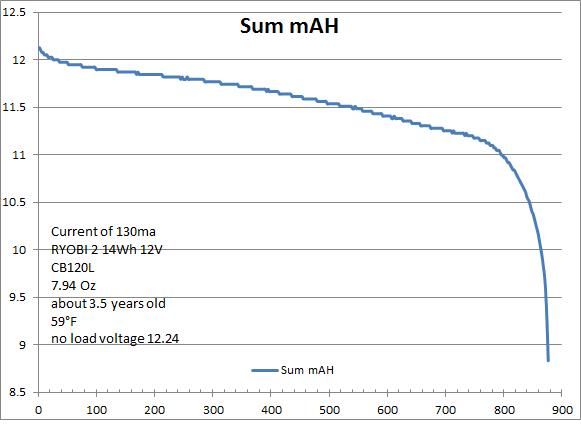
If these were new I would estimate they would cross the 10 volt line at about 1100mAH. Even at 1100 mAH they are much heavier for the power than lithium AA and these still need a water proof case.


If these were new I would estimate they would cross the 10 volt line at about 1100mAH. Even at 1100 mAH they are much heavier for the power than lithium AA and these still need a water proof case.
The question of the day is Freedom or Socialism?? MagicPaddler
02/13/2014 02:47PM
quote MagicPaddler: "NotLight
Take the amplifier out and do the comparing and gain in the ARDUINO. If interested look up “ARDUINO PID”.
Magic
"
I was more thinking you might need the op amp in case the gate of the FET needed to go above 5V, but I suppose there is some way to do that with a pullup resistor on the PWM output.
02/13/2014 04:18PM
quote NotLight: "quote MagicPaddler: "NotLight
Take the amplifier out and do the comparing and gain in the ARDUINO. If interested look up “ARDUINO PID”.
Magic
"
I was more thinking you might need the op amp in case the gate of the FET needed to go above 5V, but I suppose there is some way to do that with a pullup resistor on the PWM output.
"
NotLight
You have a point. If you use the same transistor IRF740 the gate will need to be about 4 volts higher than the source which is the current readout. To get good resolution the current readout needs to be a large percentage of the reference used on the ARDUINO (3.3V). So you would have 3V + 4V or about 7 volts. I would use a zener and a resistor to the battery+ to give the offset. The feedback loop would keep any drift from causing a error.
Magic
The question of the day is Freedom or Socialism?? MagicPaddler
02/13/2014 05:33PM
quote Ragged: "Magic you are killing me, test 8 Durcells AA's! I'll paypall you some loot for burning them up! "
It was 10 Durcell but I found a way to do the lithiums with 6. Still a lot of LOOT. I think I have found out what I wanted to know. I will be using 9 Lithiums and I have a holder that I will modify to hold them.
This is my holder.
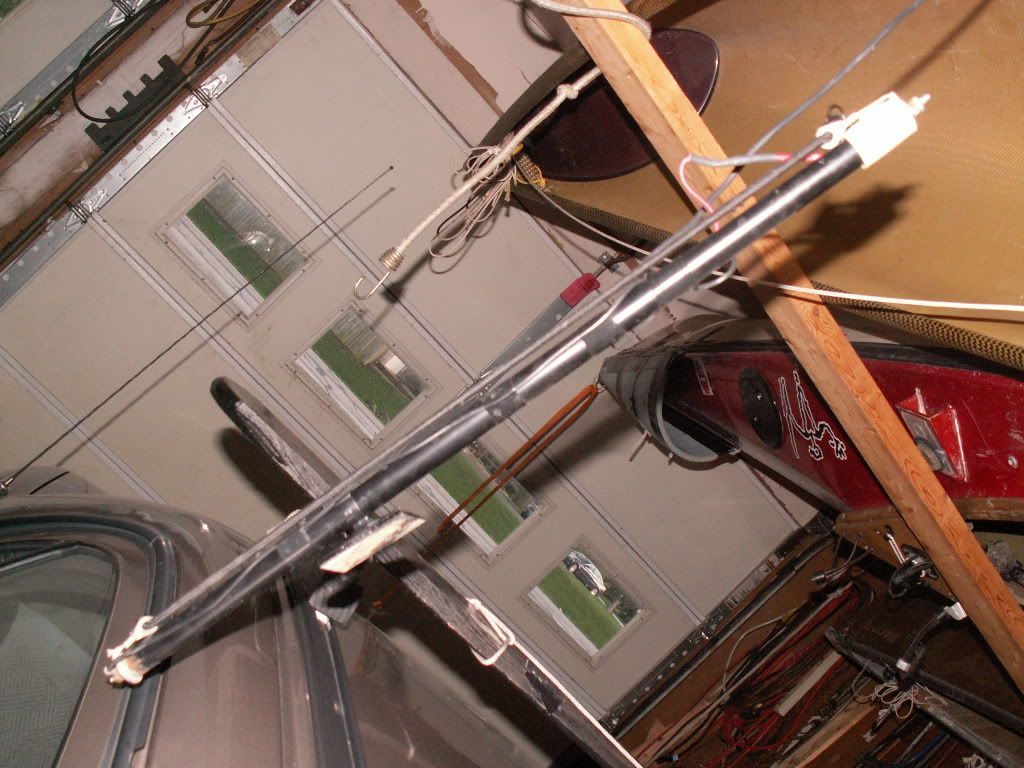
And it mounts in two of these
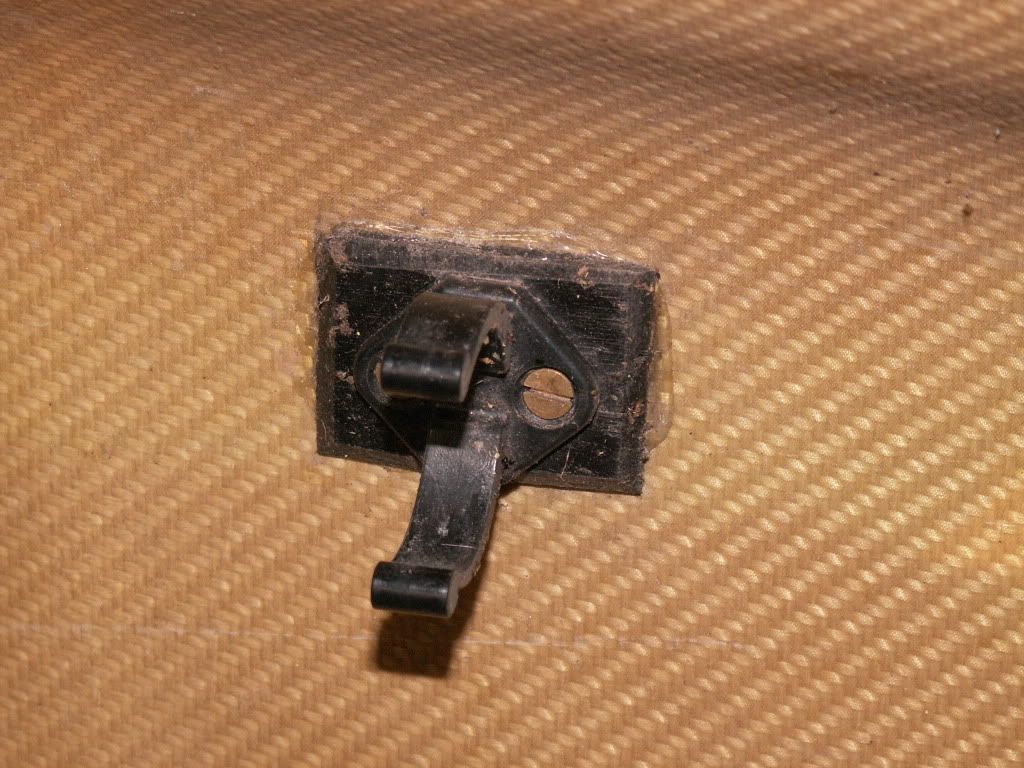
Magic
The question of the day is Freedom or Socialism?? MagicPaddler
02/14/2014 08:36AM
Below is a list of the power sources I have tested in a form that makes comparing them easier. I have found that on at trip that I fish 9 days I use about 6200 mAH from my battery pack so that is what I am requiring for a trip in the list.
Energizer ultimate lithium_____9/pack 2packs/trip______$33.30/tri________9.4 Oz/trip
Duracell Alkaline____________10/pack 4packs/trip______$51.60/trip _____2LB 3.2 Oz/trip
LiPo 5800 Rechargeable _____2batterys+protection/trip__$50/manyTrips ___2LB 123 Oz/trip
Dewalt drill battery Recharge__3batterys/trip __________$ 240/ManyTrips __5LB 7.6 Oz/Trip
Ryobi drill battery Recharge___6batterys/trip___________$???/manytrip____3 LB/trip
Duracell Quantum_________10batterys/pack 3packs/trip___$31.95/Trip____1 LB8.5 OZ/trip
***
There is an error in the cost of some of the batteries in this table see below.***
Energizer ultimate lithium_____9/pack 2packs/trip______$33.30/tri________9.4 Oz/trip
Duracell Alkaline____________10/pack 4packs/trip______$51.60/trip _____2LB 3.2 Oz/trip
LiPo 5800 Rechargeable _____2batterys+protection/trip__$50/manyTrips ___2LB 123 Oz/trip
Dewalt drill battery Recharge__3batterys/trip __________$ 240/ManyTrips __5LB 7.6 Oz/Trip
Ryobi drill battery Recharge___6batterys/trip___________$???/manytrip____3 LB/trip
Duracell Quantum_________10batterys/pack 3packs/trip___$31.95/Trip____1 LB8.5 OZ/trip
***
There is an error in the cost of some of the batteries in this table see below.***
The question of the day is Freedom or Socialism?? MagicPaddler
02/14/2014 04:07PM
quote BennyMac: "Can we start a new forum just for nuclear physicists to talk?"
Doubt it would get used much, as we usually have our spouses rapt attention. Especially when the nuclear physics intersects with topics involving exciting corporate policies and procedures.
02/15/2014 03:22PM
quote Dilligaf0220: " Ugh, me buy big battery, sonar go blinkey blinkey for days.
When sonar stop beepey beepey, me plug in.
That's as much as I need, want, and care to put in the effort to know."
I think you have It!!!!
Just buy batteries and use until they are dead - buy more - bring lots to BWCA.
02/16/2014 12:33AM
quote MagicPaddler: "Gsfisher13
I forgot to post the 10 alkaline batteries. This would be similar to what you use. That is what I have used for years and it works well. Is there something cheaper, lighter that will last longer.
Look at the 10 volt line to see how many mil amperes hours (mAH) you will get out of this battery combination.
1820 mAH, 8.8 Oz and cost about $12.90 $12.90/1.82AH = $7.08/AH
Now to compare that to Energizer Ultimate Lithium (first plot)
3200 mAH, 4.7 Oz and cost about $$16.65 $16.65/3.2AH= $5.20/AH
So the Lithiums are lighter and cheaper per hour of operation.
Ragged
Do you use over discharge protection on your LiPos? Look at my fourth graph LiPo#1. See that little glitch on the falling edge at about 10 volts. That occurred because one of the cells has gone below zero volts and that is where it shorted out raising the output voltage and irreversible destroying that cell.
I have one of THESE on order.
"
not alkaline, Sony eneloop are Ni-mh rechargeable batteries. i'm not sure I understand the time component of your graphs. my real world use, I can have the fishfinder running continuous for 4-5 hours and not run out.
02/16/2014 07:08AM
Gsfisher
You have done some measuring of your fish detector and your battery and the way you use them to get the run time. What I am trying to do is to measure battery performance in use with a load similar to a fish detector. I use the same constant load on all batteries so they can be compared. The number of batteries connected in series was chosen to provide maximum running time on a fish detector. Most detectors have good performance from 16 volts down to about 10 volts and some (very few) work well down to 8 volts. I chose battery combinations that work well down to 10 volts. To use the graphs to get expected run time on your detector you need to know 2 things about your detector. They are what is the minimum voltage your detector will work well with and how much current your detector draws. If you do not know the voltage, assume it is 10 volts. Some manufactures will list the current. I have measured my detector current with the transducer in a bucket of water. If the detector is searching for the bottom it may draw more current than normal but this still give a approximate value. Pay attention to back lighting which may draw more power than the rest of the detector. My detector is not the most power conserving detector. I have cut the wires to the back lights to conserve power on my detector and now it draws between 130 mA and 180 mA. In my comparison I used 130mA. To get the expected run time for my detector on the battery graph you copied (Duracell 1.5VLR6) on the left side find 10 (10 volts) follow that across to the blue line and then down to the bottom. That crosses the bottom line at about 1860 mAH. My detector draws 130 mA.
Time in hours=(1860 mAH)/(130 mA)
That would be a little over 14 hours.
I have also included the weight and cost of the batteries required to make that pack. So if You are going of a trip that you plan on fishing 8 hours a day for 3 days you would need batteries enough to last 24 hours. With 2 sets of batteries you should have enough.
You have done some measuring of your fish detector and your battery and the way you use them to get the run time. What I am trying to do is to measure battery performance in use with a load similar to a fish detector. I use the same constant load on all batteries so they can be compared. The number of batteries connected in series was chosen to provide maximum running time on a fish detector. Most detectors have good performance from 16 volts down to about 10 volts and some (very few) work well down to 8 volts. I chose battery combinations that work well down to 10 volts. To use the graphs to get expected run time on your detector you need to know 2 things about your detector. They are what is the minimum voltage your detector will work well with and how much current your detector draws. If you do not know the voltage, assume it is 10 volts. Some manufactures will list the current. I have measured my detector current with the transducer in a bucket of water. If the detector is searching for the bottom it may draw more current than normal but this still give a approximate value. Pay attention to back lighting which may draw more power than the rest of the detector. My detector is not the most power conserving detector. I have cut the wires to the back lights to conserve power on my detector and now it draws between 130 mA and 180 mA. In my comparison I used 130mA. To get the expected run time for my detector on the battery graph you copied (Duracell 1.5VLR6) on the left side find 10 (10 volts) follow that across to the blue line and then down to the bottom. That crosses the bottom line at about 1860 mAH. My detector draws 130 mA.
Time in hours=(1860 mAH)/(130 mA)
That would be a little over 14 hours.
I have also included the weight and cost of the batteries required to make that pack. So if You are going of a trip that you plan on fishing 8 hours a day for 3 days you would need batteries enough to last 24 hours. With 2 sets of batteries you should have enough.
The question of the day is Freedom or Socialism?? MagicPaddler
02/16/2014 10:32AM
Why not just try your luck and fish the old fashioned way? It is wilderness. Risk, challenge, skill, etc. Why not do a little research on what fish are in the lakes you're visiting, the natural behavior of that type of fish in that type of lake, and go for it? Bring a stove and some instant food if you don't have any luck that day and try for the next. Why complicate a place that's supposed to make life feel less complicated?
02/16/2014 02:29PM
quote MagicPaddler: "Below is a list of the power sources I have tested in a form that makes comparing them easier. I have found that on at trip that I fish 9 days I use about 6200 mAH from my battery pack so that is what I am requiring for a trip in the list.
Energizer ultimate lithium_____9/pack 2packs/trip______$33.30/tri________9.4 Oz/trip
Duracell Alkaline____________10/pack 4packs/trip______$51.60/trip _____2LB 3.2 Oz/trip
LiPo 5800 Rechargeable _____2batterys+protection/trip__$50/manyTrips ___2LB 123 Oz/trip
Dewalt drill battery Recharge__3batterys/trip __________$ 240/ManyTrips __5LB 7.6 Oz/Trip
Ryobi drill battery Recharge___6batterys/trip___________$???/manytrip____3 LB/trip
Duracell Quantum_________10batterys/pack 3packs/trip___$31.95/Trip____1 LB8.5 OZ/trip"
Ragged, what kind of 18650's do you use?
Just thinking out loud about it, I see the 3.7V 3400mah Panasonic 18650 batteries on amazon at ~$40 for 4 batteries. But in a sense you have to add to the BOM a charger ($20), a waterproof battery pack/protection setup (~$20), and maybe one of those 12V USB chargers if you maybe wanted to recharge a phone with the battery pack ($10). So that puts you at $90 for a 3400mah total setup. For comparison, the Goal Zero Sherpa 50 spec is 8800mah@11V in one integrated package for ~$150. Of course, it's 1.9lbs and has a ridiculously short 6month warranty - vs the 18650 setup that you could repair yourself.
But is there a cheaper way to set up the 18650's or LiPo batteries?
02/16/2014 07:44PM
Notlight
If I wanted a rechargeable system I like the 5800 mAh battery at hobbyking.
http://www.hobbyking.com/hobbyking/store/__50207__B_Grade_5800mAh_3S_25C_Lipoly_Battery.html
And I have this charger which will charge several types of batteries.
http://www.hobbyking.com/hobbyking/store/__22297__Hobbyking_ECO_SIX_80W_6A_2_6S_Battery_Balance_Charger_AC_DC_w_PSU.html
You would need discharge protection with that battery and I would use one of these.
http://www.all-battery.com/3S_li-ion.aspx
The hard part would be getting the connectors for the cards. I think they can be gotten from Hobbyking by buying a parallel adapter and cutting the connectors off and soldering them to the board.
If I wanted a rechargeable system I like the 5800 mAh battery at hobbyking.
http://www.hobbyking.com/hobbyking/store/__50207__B_Grade_5800mAh_3S_25C_Lipoly_Battery.html
And I have this charger which will charge several types of batteries.
http://www.hobbyking.com/hobbyking/store/__22297__Hobbyking_ECO_SIX_80W_6A_2_6S_Battery_Balance_Charger_AC_DC_w_PSU.html
You would need discharge protection with that battery and I would use one of these.
http://www.all-battery.com/3S_li-ion.aspx
The hard part would be getting the connectors for the cards. I think they can be gotten from Hobbyking by buying a parallel adapter and cutting the connectors off and soldering them to the board.
The question of the day is Freedom or Socialism?? MagicPaddler
02/16/2014 08:56PM
quote MagicPaddler: "Gsfisher
You have done some measuring of your fish detector and your battery and the way you use them to get the run time. What I am trying to do is to measure battery performance in use with a load similar to a fish detector. I use the same constant load on all batteries so they can be compared. The number of batteries connected in series was chosen to provide maximum running time on a fish detector. Most detectors have good performance from 16 volts down to about 10 volts and some (very few) work well down to 8 volts. I chose battery combinations that work well down to 10 volts. To use the graphs to get expected run time on your detector you need to know 2 things about your detector. They are what is the minimum voltage your detector will work well with and how much current your detector draws. If you do not know the voltage, assume it is 10 volts. Some manufactures will list the current. I have measured my detector current with the transducer in a bucket of water. If the detector is searching for the bottom it may draw more current than normal but this still give a approximate value. Pay attention to back lighting which may draw more power than the rest of the detector. My detector is not the most power conserving detector. I have cut the wires to the back lights to conserve power on my detector and now it draws between 130 mA and 180 mA. In my comparison I used 130mA. To get the expected run time for my detector on the battery graph you copied (Duracell 1.5VLR6) on the left side find 10 (10 volts) follow that across to the blue line and then down to the bottom. That crosses the bottom line at about 1860 mAH. My detector draws 130 mA.
Time in hours=(1860 mAH)/(130 mA)
That would be a little over 14 hours.
I have also included the weight and cost of the batteries required to make that pack. So if You are going of a trip that you plan on fishing 8 hours a day for 3 days you would need batteries enough to last 24 hours. With 2 sets of batteries you should have enough.
"
ok so that formula helps me understand "your" fishfinder draw
1860 maH/130 mA with "my" type of batteries and how long the batteries should last. how would I find out how much my fishfinder draws without your electrical ninja skills? any simple way?
I do understand your intentions of the post were to compare batteries with consistent draw to help determine which are the "best" batteries
02/17/2014 07:19AM
Gsfisher13
Sometime the current draw is listed in the manual. Check your batteries looking for numbers. Does your battery pack have mAh (milliAmp hours) or a Wh (Watt hours) number on it. If your battery has one of those numbers on it that can be used to get an estimate of your detector current. The mAh and the Wh on a battery are what the manufacture claims that battery will put out when it is new and at an ideal temperature and a very low current draw. I would expect that on my tester in my 60°F basement I would get about 75% of that. I get the 75% by looking at the RYOBI batteries above. If the battery voltage were absolutely constant from fully charged to drained then
Wh *1000/voltage= mAh. And for an estimate we can use that as correct. I will make up some numbers as an example. On the battery label is has 10 Wh and 12 V that would be 833 mAh or the label might have 833 mAh on it. With it being a used battery and not at ideal temperature I would expect to get 75% of that out of it. .75 * 833 = 625 mAh. If that battery would run your detector for 3 hours then 625 mAh/3hours = 208 mA. That is kind of a swag but the best I can do without instrumentation.
Sometime the current draw is listed in the manual. Check your batteries looking for numbers. Does your battery pack have mAh (milliAmp hours) or a Wh (Watt hours) number on it. If your battery has one of those numbers on it that can be used to get an estimate of your detector current. The mAh and the Wh on a battery are what the manufacture claims that battery will put out when it is new and at an ideal temperature and a very low current draw. I would expect that on my tester in my 60°F basement I would get about 75% of that. I get the 75% by looking at the RYOBI batteries above. If the battery voltage were absolutely constant from fully charged to drained then
Wh *1000/voltage= mAh. And for an estimate we can use that as correct. I will make up some numbers as an example. On the battery label is has 10 Wh and 12 V that would be 833 mAh or the label might have 833 mAh on it. With it being a used battery and not at ideal temperature I would expect to get 75% of that out of it. .75 * 833 = 625 mAh. If that battery would run your detector for 3 hours then 625 mAh/3hours = 208 mA. That is kind of a swag but the best I can do without instrumentation.
The question of the day is Freedom or Socialism?? MagicPaddler
02/23/2014 12:00PM
This is informative and gets into the fine points of electronics design, but I have a dumb question on charging.
If I got one of the Lipo or similar rechargeable batteries, could I get by with using the charger from my Vexlar depth finder or even a my car charger in the garage?
If I got one of the Lipo or similar rechargeable batteries, could I get by with using the charger from my Vexlar depth finder or even a my car charger in the garage?
02/23/2014 02:07PM
Manufactures will tell you no. If you just hook up one of the chargers you suggested and let it charge you will destroy the battery and maybe cause a fire. You have heard of the laptop catching on fire. What the problem is each cell must be monitored to prevent over charging or over discharging. There are boards built that will monitor and open a circuit to protect the battery. I mention them above from ALL-battery.com. I have one of those boards and am doing some testing. It kinda works. I am trying to run a Dewalt drill on a 4 cell battery. The board has both over charge and discharge protection. Frequently the board goes into protection mode when it should not. When it is working the drill has plenty of power and I cannot stall it. I have a 3 cell protection board and a battery I am going to try it on. If you look at a picture of the Lipo batteries there is a white multipin connector that is used to go to the protection board.
The question of the day is Freedom or Socialism?? MagicPaddler
02/23/2014 04:54PM
quote Humdinger: "This is informative and gets into the fine points of electronics design, but I have a dumb question on charging.
If I got one of the Lipo or similar rechargeable batteries, could I get by with using the charger from my Vexlar depth finder or even a my car charger in the garage?
"
I think, but I'm not sure, that for ragged's system you would also need this Special charger, plus this battery holder and protection circuit combo, plus four of these 18650 batteries. The charger comes with a 12V connector that you can plug into your car or boat (or maybe solar panel if it has a 12V output).
02/23/2014 05:50PM
quote NotLight: "THIS, I use it for all my junk, it will charge just about anything and you can fine tune the rate for whatever you are charging, most batteries will give you a spec on how fast they can be charged, I charge Lion, Lipo, Lead acid, NiMH ect..., units like this are really handy to have around and they will do balancing if you want, multicell Lipos and Lions should be balanced charged. You can get away with not doing it every time but it should be done here and there as each cell will tend to do its own thing and you could end up over discharging or charging a single cell if it got to out of whack.
I think, but I'm not sure, that for ragged's system you would also need this Special charger, plus this battery holder and protection circuit combo, plus four of these 18650 batteries. The charger comes with a 12V connector that you can plug into your car or boat (or maybe solar panel if it has a 12V output).
I use one similar to
"
He leads me beside quiet waters, he restores my soul. Psalm 23:2/3
02/23/2014 08:37PM
The battery holder from NotLight’s post lists over discharge and over charge protection. I think that means you do not need a special charger. It may just prevent over charge/discharge and not do the balancing. That would be the same as the protection cards I posted above.
The question of the day is Freedom or Socialism?? MagicPaddler
03/22/2014 01:53PM
my 1st post ..... question. i purchased a hummingbird piranhaMAX 165 portable for my next trip in june. for fishing i like to look at lake bottoms. i saw in previous visits somewhere (i can't refind) how to convert power source from heavy NP7-12, 12V7 Ah to aa batteries to lessen the weight. can anyone refer me or guide me to instructions to accomplish this task. i'm non-tech but remember others discussing advantages of 10-pak vs 8-pac. that will work. my local radio shack shop only has 8-pac option. this unit spec states 200 watts(RMS) / 800 watts (PTP) which means nothing to me but the clerk asked me what amparage is needed to operate? i left confused.
thanks in advance for any help.
thanks in advance for any help.
03/22/2014 07:42PM
The wattage they state is not like the wattage of the bulb that is lighting your room. The wattage they state is more like the power going into a strobe light. What that tells you is you can’t figure the current from the Wattage listed on a fish detector.
You are going to see some units that will confuse your if you do not know what they mean so lets start with what the units mean.
Ah is Amperes * Hours So 5 amperes for 2 hours is 10 Ah
1 mA is 1 milli Ampere which is the same as .001 amperes
mAh is milli Ampere hour which is .001 Ah
I have never measured the current draw for your type of detector but I would put money on it drawing more than 60mA and less than 250ma with the back light off. I think this detector draws less than 100mA but I do not know. A word of caution the back light may draw as much as 5 times more than the detector and you can’t tell it is on during the day time.
What I would recommend as a non-rechargeable power source for that detector is
First choice 9 (Energizer Ultimate Lithium) AA batteries in series and
Second choice 10 Duracell AA batteries in series.
The 9 Energizer Ultimate Lithium will last about 1.5 times longer than the 10 Duracell batteries.
RadioShack part 270-383 holds 4 AA batteries. If you put 2 of those in series you would have space for 8 batteries. Or part number 270-407 or 270-387 holds 8 AA batteries. Part number 270-401 holds 1 and 270-382 holds 2. Just found one that looks better yet. Buy 3 part number 270-085 they each hold 3 batteries hooked in series would give you 9 batteries in series. Radioshack has “project enclosures” that you could use for a case to put the holders in.
Different approach to battery holder. The inside diameter of ½ inch PVC pipe allows AA batteries to slip inside. I have seem battery holders made out of 2 PVC caps, short piece of PVC pipe. 2 6-32X.75 screws, 2 ring terminals, and some bungee cord. Similar to the one pictured above that is made out of stainless steel with PVC cap. If the PVC caps are domed put a nut on the screw before you put it through the cap.
Tell us what you end up doing and how it worked.
You are going to see some units that will confuse your if you do not know what they mean so lets start with what the units mean.
Ah is Amperes * Hours So 5 amperes for 2 hours is 10 Ah
1 mA is 1 milli Ampere which is the same as .001 amperes
mAh is milli Ampere hour which is .001 Ah
I have never measured the current draw for your type of detector but I would put money on it drawing more than 60mA and less than 250ma with the back light off. I think this detector draws less than 100mA but I do not know. A word of caution the back light may draw as much as 5 times more than the detector and you can’t tell it is on during the day time.
What I would recommend as a non-rechargeable power source for that detector is
First choice 9 (Energizer Ultimate Lithium) AA batteries in series and
Second choice 10 Duracell AA batteries in series.
The 9 Energizer Ultimate Lithium will last about 1.5 times longer than the 10 Duracell batteries.
RadioShack part 270-383 holds 4 AA batteries. If you put 2 of those in series you would have space for 8 batteries. Or part number 270-407 or 270-387 holds 8 AA batteries. Part number 270-401 holds 1 and 270-382 holds 2. Just found one that looks better yet. Buy 3 part number 270-085 they each hold 3 batteries hooked in series would give you 9 batteries in series. Radioshack has “project enclosures” that you could use for a case to put the holders in.
Different approach to battery holder. The inside diameter of ½ inch PVC pipe allows AA batteries to slip inside. I have seem battery holders made out of 2 PVC caps, short piece of PVC pipe. 2 6-32X.75 screws, 2 ring terminals, and some bungee cord. Similar to the one pictured above that is made out of stainless steel with PVC cap. If the PVC caps are domed put a nut on the screw before you put it through the cap.
Tell us what you end up doing and how it worked.
The question of the day is Freedom or Socialism?? MagicPaddler
03/22/2014 07:56PM
quote jimhill81: "my 1st post ..... question. i purchased a hummingbird piranhaMAX 165 portable for my next trip in june. for fishing i like to look at lake bottoms. i saw in previous visits somewhere (i can't refind) how to convert power source from heavy NP7-12, 12V7 Ah to aa batteries to lessen the weight. can anyone refer me or guide me to instructions to accomplish this task. i'm non-tech but remember others discussing advantages of 10-pak vs 8-pac. that will work. my local radio shack shop only has 8-pac option. this unit spec states 200 watts(RMS) / 800 watts (PTP) which means nothing to me but the clerk asked me what amparage is needed to operate? i left confused.
thanks in advance for any help."
I responded to your other post about converting the power source, but just wanted to mention that the overall key is operating voltage. Most finders operate at 12 volts, but if you look at the manuals it will give a voltage range, typically 10-18. Each AA battery will supply 1.5 volts, so 8 in series will give you 12 volts. The ten battery pack is better because that will give you 15 volts, still in the operating range of your unit, but your finder can operate for a much longer time, as you are still getting at least 10 volts with 1/3 loss in battery power, were with an 8pack, a 1/3 loss of battery power would drop below 10 volts and your finder will not work. You can get milli amp power draw info from your finder manual, or email humminbird customer service. With that info you can easily calculate how long your batteries will last.
Moonman
03/23/2014 05:25PM
again, thanks to all for your advise. this will be fun for me.. that's what it's all about. re electronics in the wilderness let's all just go and 'enjoy'. i assume we are on vacation. i personally love to fish and know how important underwater structure is to fish habitat. i'll sacrafice the weight of a great meal anyday in exchange for the portable hummingbird. safe travels to all.
04/10/2014 01:34PM
Earlier in this thread I have tried to cover the battery capacity of several battery options in this post I have some data on what current to expect some detectors to draw. I tested 4 fish detectors at a range of depths to see what their current draw was. The detectors tested were Lowrence X4, Eagle Fishmart 320, Eagle Cuda128, and Eagle Cuda300. All tests were with the back light turned off and ping speed was the default. Three of the detectors have data showing it was taken at 1 foot and this data is actually the current stated in the owner’s manual. This shows that if you use the owner’s manual value for current in calculating battery life you should have some battery capacity to spare.


The question of the day is Freedom or Socialism?? MagicPaddler
09/13/2014 09:39PM
quote CanoeKev: "We use 8 AA alkaline and they last us the whole trip. What am I missing here?"
I think his data says:
1. 10 alkaline AAs may last twice as long as 8 alkaline AAs in a fish finder, because of the way the voltage drops on the alkalines during use. (Some people may use their fish finder more hours on a trip, or have color and GPS, etc., and for them that is useful information.)
2. Energizer ultimate lithiums, even though ridiculously expensive, are not a bad deal, because they have ~2x the juice as a normal AA battery - plus they are much lighter. (Again, assuming some people might use their fish finder more often on a trip).
(Again, thanks for all this data MagicPaddler.)
09/15/2014 10:15PM
quote mutz: "I would expect to see this in February when total and complete boredom sets in."
February is high season for winter fun. I think it's more like like mid-March when the urgent need to test batteries, adhesives, water boil times, etc. finally sets in.
09/28/2014 12:19PM
I just brought a Lowrance X4 Pro, portable, new, up to Quetico for a week and the batteries were great (8 D cell Energizer). I brought a backup set but did not need it and probably used it for 30 hours. I'm going to use it here in Florida with my Kayak until the batteries die so at that point will know actual longevity, but the unit worked perfectly. Next time I won't carry the backup set of batteries because of weight. Maybe they will come out with a good Lithium battery in the D size someday. That will save on the weight issue!
If we aren't actively working to protect our planet, we are acquiescing to those who run their life as if their personal WANTS are the only things that matter. John
09/28/2014 01:41PM
Thanks mapsguy that is good information.
I have measured the current on a Lowrence X4 over the depth up to 45 Ft and found it to be under 90mA. The X4 Pro is a dual beam. I would like to know how much current the X4 Pro draws.
I would expect the X4 to run about 150 hours on 10 D alkaline cells and about 46 hours on 8 D alkaline cells.
Let us know how many hours you get out of those batteries. If that unit will measure its input voltage it would be helpful to know what the voltage is when the unit starts to not work correctly. Many times the detector will work fine in 10 Ft of water but not work in 40 Ft.
I have measured the current on a Lowrence X4 over the depth up to 45 Ft and found it to be under 90mA. The X4 Pro is a dual beam. I would like to know how much current the X4 Pro draws.
I would expect the X4 to run about 150 hours on 10 D alkaline cells and about 46 hours on 8 D alkaline cells.
Let us know how many hours you get out of those batteries. If that unit will measure its input voltage it would be helpful to know what the voltage is when the unit starts to not work correctly. Many times the detector will work fine in 10 Ft of water but not work in 40 Ft.
The question of the day is Freedom or Socialism?? MagicPaddler
09/28/2014 01:56PM
The voltage measurement was running between 11.3 and 10.9 according to the device as using it. I'm not sure what that means though! I was accurately (I believe) measuring depths up to 175 feet on Pickerel.... I didn't notice any depth issues, except when the suction cup had let go! We did a LOT of trolling. I mounted the transducer near the stern, where I could get to it. I did NOT have backlighting turned on. When paddling hard against the wind, there were many false FISH returns, but no bottom issues, and of course, the reattaching of the transducer every 30 minutes or so. That wasn't a big deal to me.
I am very happy with the unit!
I am very happy with the unit!
If we aren't actively working to protect our planet, we are acquiescing to those who run their life as if their personal WANTS are the only things that matter. John
09/28/2014 06:51PM
Mapsguy
As the batteries discharge the voltage will go down. Eventually the voltage will be so low the unit will not function well. You may not even notice that the detector is not performing at its peak. Most detectors work well until the voltage gets below 10 volts. Many detectors will stay on as the voltage drops but perform poorly and shut down completely at about 8 volts. Check your manual I think it will say your detector will work from 10 to 18 volts. If your voltage has not dropped below 10.9 V your detector should be operating well.
If your batteries under load measure 10.9 and there are 8 of them then about 1800 mAh have been used and those batteries are 14000 mAh batteries. You have 8 batteries so when 4500 mAh have been used up the output of the 8 batteries will have dropped to about 10 volts and the X4 will not operate at its best. From this I would estimate that your detector will operate another 40 hours on those batteries before the voltage drops below 10 volts.
We need you to find out how long those batteries will last. So if the little lady asks what you are doing out fishing all the time you can tell her you are doing battery research. We will back up your story.
Good to hear you like the X4.
As the batteries discharge the voltage will go down. Eventually the voltage will be so low the unit will not function well. You may not even notice that the detector is not performing at its peak. Most detectors work well until the voltage gets below 10 volts. Many detectors will stay on as the voltage drops but perform poorly and shut down completely at about 8 volts. Check your manual I think it will say your detector will work from 10 to 18 volts. If your voltage has not dropped below 10.9 V your detector should be operating well.
If your batteries under load measure 10.9 and there are 8 of them then about 1800 mAh have been used and those batteries are 14000 mAh batteries. You have 8 batteries so when 4500 mAh have been used up the output of the 8 batteries will have dropped to about 10 volts and the X4 will not operate at its best. From this I would estimate that your detector will operate another 40 hours on those batteries before the voltage drops below 10 volts.
We need you to find out how long those batteries will last. So if the little lady asks what you are doing out fishing all the time you can tell her you are doing battery research. We will back up your story.
Good to hear you like the X4.
The question of the day is Freedom or Socialism?? MagicPaddler
10/09/2014 04:45PM
Great info here guys. After reading this, I changed my portable Hummingbird 170 Pirahamax setup to run off 10 AA eneloops while before I had 8. Should make a good bit of difference in runtime. I did have a spinoff question.. has anyone tested battery usage in grayscale vs color displays? I'm temped to upgrade to a color unit but I have to think it would draw more battery... if not only for the reason that you have to have the backlight on at least the lowest level to view those color screens while the grayscale models can be viewed in daylight using no backlight. Any thoughts?
10/10/2014 09:44AM
Timmy
The back light is a power hog!! The reports I get from the new color display users is they love the fish detector but they are using2 sets of D battery packs to run the thing for a week. How long have you been using the rechargeable? I am interested in how long they last.
Mnpat
I assume you are using 8 alkaline batteries. If 8 AA were lasting through a trip for me I would not switch to 10 because I do not want to carry the extra weight.
If you have the opportunity to do a longer trip and your batteries may not last that long then what is your best choice in batteries. This trip also has many long portages in it and you do not want to carry extra weight of a lot of batteries. If I were to advise you on batteries for this dream trip assuming you had been using regular 8 regular alkaline batteries and lasting most of the week to switch to Energizer Ultimate Lithium. I would choose this for you because you already have the holder and they would last approximately 3.7 times as long. The lithiums are expensive about $15.00 for a set of 8. If you do not want to go with the expensive lithiums the above graphs show that 10 alkaline batteries will run a detector a little over 2 times as long 8 alkaline batteries. There is also a comparison of regular Duracell Alkaline and Duracell Quantum Alkaline batteries and the Quantum will power your device about 25% longer.
All
From data that I took I have found that 8 Energizer Ultimate Lithium is the optimum number.
I would like to get power requirements data on more detectors. The detectors I want to test are the small ones like the CudaXXX. I have not tested any of the Humming Bird brand but would like to. To test them I need to take them to a lake for about a 30 minute paddle. All of my previous testing has been in a lake in Bolingbrook Illinois and that would be my preferred testing spot. If anyone who lives nearby would loan me a detector I would appreciate it.
The back light is a power hog!! The reports I get from the new color display users is they love the fish detector but they are using2 sets of D battery packs to run the thing for a week. How long have you been using the rechargeable? I am interested in how long they last.
Mnpat
I assume you are using 8 alkaline batteries. If 8 AA were lasting through a trip for me I would not switch to 10 because I do not want to carry the extra weight.
If you have the opportunity to do a longer trip and your batteries may not last that long then what is your best choice in batteries. This trip also has many long portages in it and you do not want to carry extra weight of a lot of batteries. If I were to advise you on batteries for this dream trip assuming you had been using regular 8 regular alkaline batteries and lasting most of the week to switch to Energizer Ultimate Lithium. I would choose this for you because you already have the holder and they would last approximately 3.7 times as long. The lithiums are expensive about $15.00 for a set of 8. If you do not want to go with the expensive lithiums the above graphs show that 10 alkaline batteries will run a detector a little over 2 times as long 8 alkaline batteries. There is also a comparison of regular Duracell Alkaline and Duracell Quantum Alkaline batteries and the Quantum will power your device about 25% longer.
All
From data that I took I have found that 8 Energizer Ultimate Lithium is the optimum number.
I would like to get power requirements data on more detectors. The detectors I want to test are the small ones like the CudaXXX. I have not tested any of the Humming Bird brand but would like to. To test them I need to take them to a lake for about a 30 minute paddle. All of my previous testing has been in a lake in Bolingbrook Illinois and that would be my preferred testing spot. If anyone who lives nearby would loan me a detector I would appreciate it.
The question of the day is Freedom or Socialism?? MagicPaddler
10/10/2014 12:39PM
Magic Paddler,
Anything wrong with 10 Energizer L91 cells for power? You said 8 was optimal. I use 10 eneloops but as you say, would probably spring for the L91 cells if I wanted to save a little weight and extend run time.
And by the way, I have not done much real world testing on my Humminbird 170 with 10 eneloops, but when I was running 8 eneloops, it seemed to last maybe 4 outings locally where I ran it for maybe 4 hours before I got a low battery beep.
Anything wrong with 10 Energizer L91 cells for power? You said 8 was optimal. I use 10 eneloops but as you say, would probably spring for the L91 cells if I wanted to save a little weight and extend run time.
And by the way, I have not done much real world testing on my Humminbird 170 with 10 eneloops, but when I was running 8 eneloops, it seemed to last maybe 4 outings locally where I ran it for maybe 4 hours before I got a low battery beep.
10/10/2014 01:27PM
The lithium batteries like the L91 are a higher voltage battery and with new batteries a bank of 10 the voltage would be over the maximum the detector manuals recommend. Would it destroy your detector_ I doubt it but there is nothing to gain over using 8. Actually 8 lithium batteries will run a detector longer than 10 lithium batteries because the detector draws more current at higher voltage. Ya I know you already got the holder.
The eneloops have lots of energy left until they get below 1.1 volts. So you need enough 1.1 volt batteries to get above 10 volts.
The eneloops have lots of energy left until they get below 1.1 volts. So you need enough 1.1 volt batteries to get above 10 volts.
The question of the day is Freedom or Socialism?? MagicPaddler
10/10/2014 02:15PM
Well, no worries there! I have a 8 holder that I will use with L91s, and a 10 holder that I'll use with the eneloops! They will just swap out with the stud connector. So I have my wilderness lithium setup and my local lake rechargeable setup!
quote MagicPaddler: "The lithium batteries like the L91 are a higher voltage battery and with new batteries a bank of 10 the voltage would be over the maximum the detector manuals recommend. Would it destroy your detector_ I doubt it but there is nothing to gain over using 8. Actually 8 lithium batteries will run a detector longer than 10 lithium batteries because the detector draws more current at higher voltage. Ya I know you already got the holder.
The eneloops have lots of energy left until they get below 1.1 volts. So you need enough 1.1 volt batteries to get above 10 volts.
"
12/13/2014 12:45PM
There were some Camelion Lithium batteries on sale that looked like a good deal. Looking at there not on sale prices and my test data the Camelions cost .77 times as much and has .85 times as much energy. So you could save a little money but the Camelions were not all alike so you are more likely to get a bad one. One bad one in the stack would shut your detector off and you would not know which battery was the problem.


The question of the day is Freedom or Socialism?? MagicPaddler
12/13/2014 11:46PM
quote NotLight: "Cool idea. I wonder if you could just use the PWM or a DAC off the Arduino to drive the FET directly - then you could program the load to anything you wanted.
I've been thinking of chucking all my crappy eveready rechargeable NiMH AA's and buying the Sanyo Eneloop-XX AA batteries and a solar panel. Not exactly sure how you'd charge 10 AA's at the same time though. But if you could, you could maybe go to AAA's and then maybe get your battery pack weight down to 6oz or so.
"
Are you speaking Greek or something?
aka HermitThrush "Such sights as this are reserved for those who will suffer to behold them." -Eric Sevareid
12/27/2014 11:15PM
MP, haven'for read thru all this in detail yet, but just wanted to bring up something in case you'be missed it...don't know about ALL detectors, but my piranhamax is a constant power load, and I'd be willing to bet that most modern units are. The higher the input voltage, the lower the current draw and vice versa. This feature makes it even more desirable to run with 10 cells vs 8, as you get lower initial current draw in addition to the added capacity of the extra 2 batteries.
12/28/2014 08:57AM
Bonvicken
I do not have access to a newer detector but the one I have tested does increase current with higher voltage but not at a rate equal to the increase in voltage. From my notes on my detector below you can see the current does go up as voltage goes up. What you say your detector does is very possible and I would hope that the manufactures would take advantage of this technology. I think manufactures have catered to the hi horse power boats where a little extra power is not a problem.
PS I do not recommend this detector to canoeists. (too heavy, uses too much power, Back light may be on during day and you will not know it)
Eagle fish Mark 320 current draw. Voltage is
power supply meter with a fluke multimeter
in series to measure the current. Transducer is
glued to bottom of canoe not in the water.
Volts Imin Imax Iave
8 84ma 332ma 104ma
9 88ma 372ma 111ma
10 88ma 456ma 116ma
11 92ma 476ma 121ma
12 92ma 476ma 131ma
13 96ma 612ma 132ma
14 96ma 448ma 136ma
15 100ma 492ma 141ma
16 100ma 532ma 148ma
17 104ma 560ma 153ma
I do not have access to a newer detector but the one I have tested does increase current with higher voltage but not at a rate equal to the increase in voltage. From my notes on my detector below you can see the current does go up as voltage goes up. What you say your detector does is very possible and I would hope that the manufactures would take advantage of this technology. I think manufactures have catered to the hi horse power boats where a little extra power is not a problem.
PS I do not recommend this detector to canoeists. (too heavy, uses too much power, Back light may be on during day and you will not know it)
Eagle fish Mark 320 current draw. Voltage is
power supply meter with a fluke multimeter
in series to measure the current. Transducer is
glued to bottom of canoe not in the water.
Volts Imin Imax Iave
8 84ma 332ma 104ma
9 88ma 372ma 111ma
10 88ma 456ma 116ma
11 92ma 476ma 121ma
12 92ma 476ma 131ma
13 96ma 612ma 132ma
14 96ma 448ma 136ma
15 100ma 492ma 141ma
16 100ma 532ma 148ma
17 104ma 560ma 153ma
The question of the day is Freedom or Socialism?? MagicPaddler
03/04/2015 09:15AM
Batteries purchased from Costco. Evidently not the same battery sold by Costco in Europe.

I found one battery bad in the set. I will repeat the test with a new set of batteries.I repeated the test and replaced the graph.

I found one battery bad in the set. I will repeat the test with a new set of batteries.I repeated the test and replaced the graph.
The question of the day is Freedom or Socialism?? MagicPaddler
04/20/2015 07:16AM
New technology batteries are making it to market. Four of the 3400mAh batteries in series would run and average detector about 34 hours. They have protection built in so you cannot over discharge them. The over charge protection may be in the battery or in the charger. It is interesting to see the 4000mAh battery is cheaper than the 3400 mAh battery. Set of four 3400 mAh batteries and a charger for $79.95
4000mAh battery for $15.00
There are better pricing for batteries and protection but the protection is external to the battery. There will be something on the market before long for a battery pack with easily connectable protection. I am running a detector on a 5000 mAh Lipoly battery that cost $23. But it requires a protection board which cost about $20.00 the protection board requires that connectors be soldered to it and put in a protective case.
4000mAh battery for $15.00
There are better pricing for batteries and protection but the protection is external to the battery. There will be something on the market before long for a battery pack with easily connectable protection. I am running a detector on a 5000 mAh Lipoly battery that cost $23. But it requires a protection board which cost about $20.00 the protection board requires that connectors be soldered to it and put in a protective case.
The question of the day is Freedom or Socialism?? MagicPaddler
01/25/2016 11:51AM
I found a source for batteries that if they meet specks they would be GREAT. That is 4 batteries and a charger for less than $6. With 3 of 3.7 Volt 9800mAh batteries in series they would run a fish detector for 98 hours. WOW! Here is a link so you can see what they look like BUT DO NOT BUY THEM.
EDIT (Something went wrong with the link it is at the bottom of the post.)
I did a discharge test on a set of 3 batteries after using the supplied charger to fully charge them. I used a discharge current of 106mA so it would be similar to a fish detector. If they were tested at a current like these batteries were intended to be used the results would have been worse.
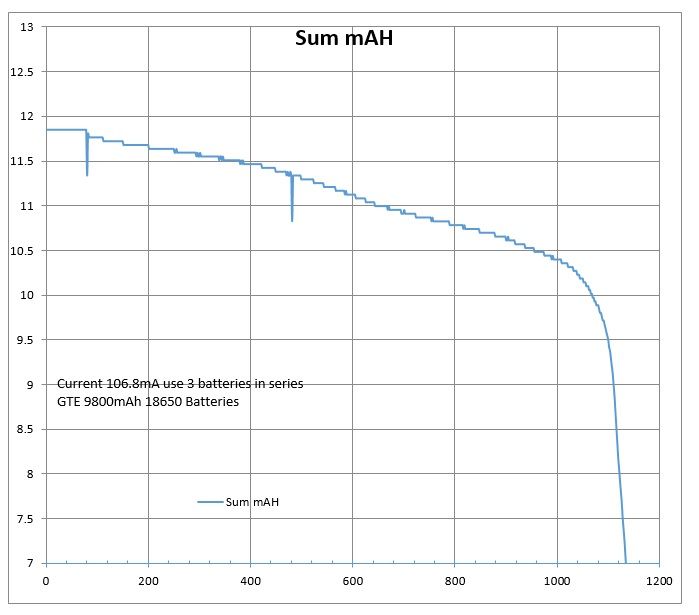
That is it they will put out about 1000mAh. Only low by a factor of 10. I have checked results for other people testing many brands and the best batteries from the best manufactures this size will put out about 4000mAh. The moral of this story is if it is too good to be true it is not true.
a lying sales mans site.
EDIT (Something went wrong with the link it is at the bottom of the post.)
I did a discharge test on a set of 3 batteries after using the supplied charger to fully charge them. I used a discharge current of 106mA so it would be similar to a fish detector. If they were tested at a current like these batteries were intended to be used the results would have been worse.

That is it they will put out about 1000mAh. Only low by a factor of 10. I have checked results for other people testing many brands and the best batteries from the best manufactures this size will put out about 4000mAh. The moral of this story is if it is too good to be true it is not true.
a lying sales mans site.
The question of the day is Freedom or Socialism?? MagicPaddler
01/25/2016 04:35PM
Thank your for the awesome research magic paddler.
So I'm wondering based on my limited knowledge. (Very limited). I used AAs last year for the first time after reading your new battery holder post (I made one)...But I did burn through 2 sets of 10 alkaline AAs on my trip.
Questions:
1. It would seem to me that C's might offer the best non-lithium option-especially after seeing the curve above. 10cs weigh in at 1lb 7oz and will power your finder all week long (Your graph shows approx 6k) What am I missing?- why are Cs not more popular? Also- C's are a great price point- cheap cs can be found for under$1 battery. Even if cheap Cs don't have the life of a good c , anywhere around 6k is quite a lot.
2. What is the "loss" in life from a cheap alkaline to a premium alkaline like those which you tested?. 25%??
3. Lastly, based on my limited(again) knowledge, putting batteries in parallel does not increase voltage but does add life to the entire series. So, if my fish finder runs well on 9, then would it be beneficial to put the 10th in parallel rather than in series to increase the life of the entire supply? Thanks for your wisdom.
So I'm wondering based on my limited knowledge. (Very limited). I used AAs last year for the first time after reading your new battery holder post (I made one)...But I did burn through 2 sets of 10 alkaline AAs on my trip.
Questions:
1. It would seem to me that C's might offer the best non-lithium option-especially after seeing the curve above. 10cs weigh in at 1lb 7oz and will power your finder all week long (Your graph shows approx 6k) What am I missing?- why are Cs not more popular? Also- C's are a great price point- cheap cs can be found for under$1 battery. Even if cheap Cs don't have the life of a good c , anywhere around 6k is quite a lot.
2. What is the "loss" in life from a cheap alkaline to a premium alkaline like those which you tested?. 25%??
3. Lastly, based on my limited(again) knowledge, putting batteries in parallel does not increase voltage but does add life to the entire series. So, if my fish finder runs well on 9, then would it be beneficial to put the 10th in parallel rather than in series to increase the life of the entire supply? Thanks for your wisdom.
01/25/2016 06:57PM
quote Grizzlyman: "Thank your for the awesome research magic paddler.
So I'm wondering based on my limited knowledge. (Very limited). I used AAs last year for the first time after reading your new battery holder post (I made one)...But I did burn through 2 sets of 10 alkaline AAs on my trip.
Questions:
1. It would seem to me that C's might offer the best non-lithium option-especially after seeing the curve above. 10cs weigh in at 1lb 7oz and will power your finder all week long (Your graph shows approx 6k) What am I missing?- why are Cs not more popular? Also- C's are a great price point- cheap cs can be found for under$1 battery. Even if cheap Cs don't have the life of a good c , anywhere around 6k is quite a lot.
2. What is the "loss" in life from a cheap alkaline to a premium alkaline like those which you tested?. 25%??
3. Lastly, based on my limited(again) knowledge, putting batteries in parallel does not increase voltage but does add life to the entire series. So, if my fish finder runs well on 9, then would it be beneficial to put the 10th in parallel rather than in series to increase the life of the entire supply? Thanks for your wisdom. "
1: Using C is a viable option. The C I tested would run a 100mA detector for about 65 hours. That would weigh about 21 Oz. Compare that to IKEA AA batteries. With IKEA AA and using 3 sets of10 batteries you could run the same detector for 69 hours and it would weigh 22 Oz. So it is about the same weight for the same number of hours of operations. Now I only tested one type of C cell there may be a better brand than the ones I tested. Personally I don’t like putting all my eggs in one basket or if you only have one set of batteries and leave the detector on all night you are out of batteries. I one time owned a detector that the power button turned the light on and if you were not careful when you tried to turn the detector off you actually turned the back light on.
2 All of the AA alkaline batteries I tested have a reputation of being good batteries. Depending on how you calculate the different output mAh percentage the spread was between 20% and 30%. But where the big difference came is in price. IKEA batteries was close to the most output and by far the least expensive. A set of 10 IKEA AA batteries would cost $2.00 and run a detector for 23 and ½ hours. You will pay over $10 for a set of some brands that will run your detector for less time.
3 That will not work. If you put 9 in series and put 1 in parallel with the 9 they all will get hot and go dead. If you had 2 sets of 9 you could put them in parallel and that would actually give you just a hair more than twice as much as one set but not enough to bother. You would be better off with sets of 10 in series.
The question of the day is Freedom or Socialism?? MagicPaddler
01/27/2016 09:04AM
quote MagicPaddler: "quote Grizzlyman: "Thank your for the awesome research magic paddler.
So I'm wondering based on my limited knowledge. (Very limited). I used AAs last year for the first time after reading your new battery holder post (I made one)...But I did burn through 2 sets of 10 alkaline AAs on my trip.
Questions:
1. It would seem to me that C's might offer the best non-lithium option-especially after seeing the curve above. 10cs weigh in at 1lb 7oz and will power your finder all week long (Your graph shows approx 6k) What am I missing?- why are Cs not more popular? Also- C's are a great price point- cheap cs can be found for under$1 battery. Even if cheap Cs don't have the life of a good c , anywhere around 6k is quite a lot.
2. What is the "loss" in life from a cheap alkaline to a premium alkaline like those which you tested?. 25%??
3. Lastly, based on my limited(again) knowledge, putting batteries in parallel does not increase voltage but does add life to the entire series. So, if my fish finder runs well on 9, then would it be beneficial to put the 10th in parallel rather than in series to increase the life of the entire supply? Thanks for your wisdom. "
1: Using C is a viable option. The C I tested would run a 100mA detector for about 65 hours. That would weigh about 21 Oz. Compare that to IKEA AA batteries. With IKEA AA and using 3 sets of10 batteries you could run the same detector for 69 hours and it would weigh 22 Oz. So it is about the same weight for the same number of hours of operations. Now I only tested one type of C cell there may be a better brand than the ones I tested. Personally I don’t like putting all my eggs in one basket or if you only have one set of batteries and leave the detector on all night you are out of batteries. I one time owned a detector that the power button turned the light on and if you were not careful when you tried to turn the detector off you actually turned the back light on.
2 All of the AA alkaline batteries I tested have a reputation of being good batteries. Depending on how you calculate the different output mAh percentage the spread was between 20% and 30%. But where the big difference came is in price. IKEA batteries was close to the most output and by far the least expensive. A set of 10 IKEA AA batteries would cost $2.00 and run a detector for 23 and ½ hours. You will pay over $10 for a set of some brands that will run your detector for less time.
3 That will not work. If you put 9 in series and put 1 in parallel with the 9 they all will get hot and go dead. If you had 2 sets of 9 you could put them in parallel and that would actually give you just a hair more than twice as much as one set but not enough to bother. You would be better off with sets of 10 in series.
"
Awesome. Thank you. I'm going to make a c holder. I'll report back w pics
04/15/2016 02:38PM
I have a Piranhamax 175. I measured the current draw on my unit at depths from 5 FT to 75 FT. I found that with the unit set to use the 200K Hz it drew about 75 ma. at all depths. With the unit set to use the 455K Hz it drew about 88 ma. at all depths. When the back light is full on the current draw increases by 20m A. When an alarm beeper is going off it increases the current by about 5 mA. These measurements were taken with about 13 volts applied to the detector.
The question of the day is Freedom or Socialism?? MagicPaddler
06/22/2016 10:28AM
If you are considering purchasing rechargeable batteries a word of caution and good news. The word of caution is that many of the stated capacities are false. The good news is there is a site where you can get test results on many batteries.
TESTS FOR 18650 BATTERIES and TESTS FOR 26650 Batteries.
The reason I trust this site is they tested the one battery type I tested and got the same results.
TESTS FOR 18650 BATTERIES and TESTS FOR 26650 Batteries.
The reason I trust this site is they tested the one battery type I tested and got the same results.
The question of the day is Freedom or Socialism?? MagicPaddler
Subscribe to Thread
Become a member of the bwca.com community to subscribe to thread and get email updates when new posts are added. Sign up Here







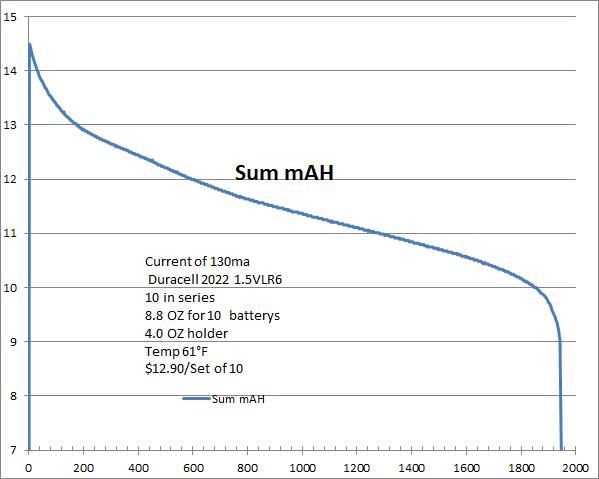
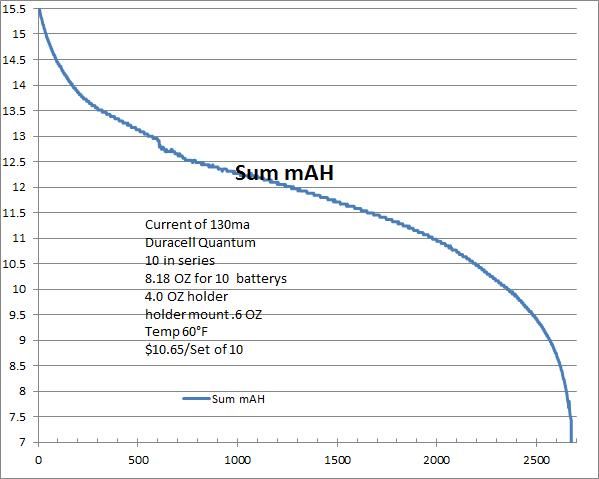


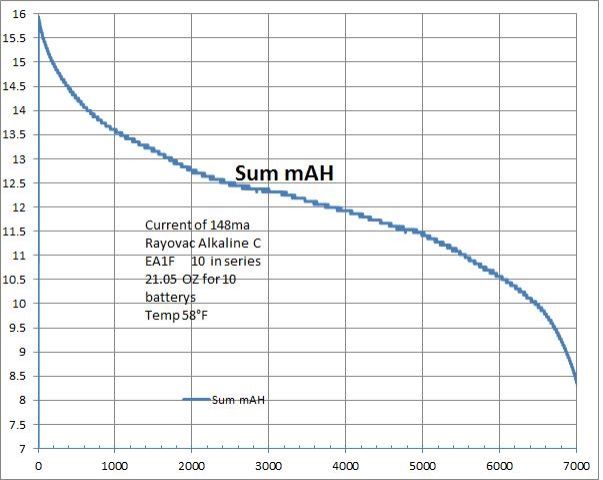
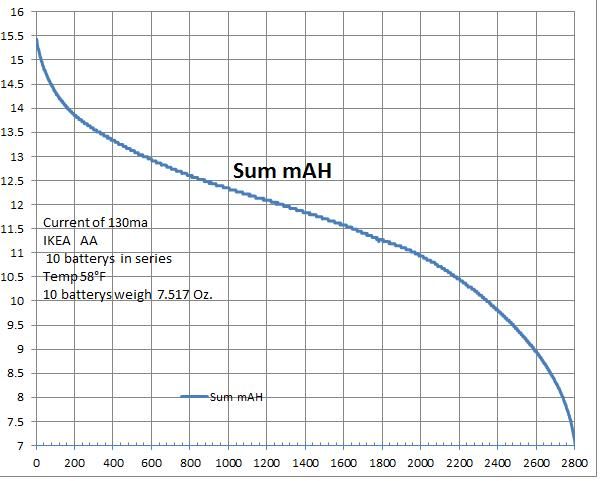

 Search BWCA.com
Search BWCA.com
 Donate
Donate 